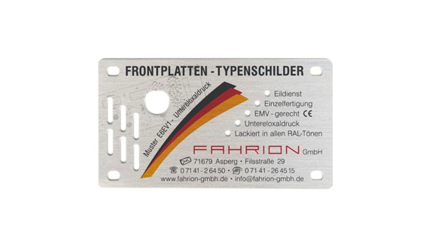Fahrion GmbH - Anodized printing
Anodized printing is a special printing proce- dure that is only used for anodized alumi- num. What is special about it is that the ink penetrates into the surface of the aluminum and does not lie on the surface of the printed material. This yields printed material that is wipe and scratch resistant and resists oil and diluent. Even finger oils do not affect the print. Due to these advantages, ano- dized printing is used quite frequently for front panels where the print needs to be retained for years even under continuous use. Rating plates benefit from anodized printing that resists oils and diluents.
 Galvanizing
Galvanizing
You can easily determine if anodized printing was used on aluminum merely by scratching the print with your fingernail. If the print is slightly elevated, anodized printing was not used. If however the print is not elevated, anodized printing was used.
 Sample business card with anodized printing
Sample business card with anodized printing
In anodized printing, the anodizing process is interrupted and a special anodizing ink is applied in a screen printing process on the unsealed aluminum surface. The ink is absorbed into the open pores of the anodized layer. Then the aluminum anodizing process is finished (sealing) in that a very thin oxide layer is created that covers the particles of ink. This layer can be so thin that it is trans- parent. Then the excess ink is washed off.
Despite all the advantages, there are a few restrictions in anodized printing:
1.) The specific anodized printing inks cannot be mixed like normal screen printing inks. You are therefore limited to a few colors. Company logos that use RAL, HKS or Pantone colors can generally not be printed using anodized printing. However, it is possible to print the normal text on the front panel with anodized printing and use regular screen printing for the company logo. This allows the advantages of both printing methods to be combined.
2.) The saturation of the printed inks depends on the thickness of the oxide layer, the geometry of the pores, the type of aluminium alloy that is used, etc. It is impossible for all of these parameters to remain completely consistent. Slight fluctuations in the colors can occur.
3.) If the print deviates slightly, you cannot just wash off the front panel and reprint it. Since the ink quickly penetrates into the open pores, the front panel or sign needs to be pickled and anodized a second time. This can be a problem with individual items or small series of less than 10 since re-pickling and anodizing the surface frequently impairs the quality.
4.) Since the pores of the anodized surface close by themselves over time, anodized printing needs to quickly follow anodizing. The unsealed anodized surface is highly sensitive to impu- rities of all kinds (such as dust and finger oils).
It is therefore a great advantage for Fahrion GmbH to offer both anodizing and printing.
Anodized printing of front panels that need to be anodized individually is only slightly more expensive than normal screen printing. The process is significantly more expensive for front panels that have already been anodized since they first need to be stripped, then re-anodized and sealed. In addition, the anodized front panels need to be tested first to see if they can undergo additional anodizing.
 Bochonow - Drucktisch 3000 plus
Bochonow - Drucktisch 3000 plus
Your contacts:
Olga Herb
Order processing:
E-Mail: info@fahrion-gmbh.de
Telefon: +49 (0) 71 41 / 26 45-36
Fax: +49 (0) 71 41 / 26 45-15
Josua Sinka
Order processing:
E-Mail: info@fahrion-gmbh.de
Telefon: +49 (0) 71 41 / 26 45-37
Fax: +49 (0) 71 41 / 26 45-15
Buchhaltung
Buchhaltung
E-Mail: buchhaltung@fahrion-gmbh.de
Telefon: +49 (0) 71 41 / 2645-24
Fax: +49 (0) 71 41 / 26 45-15
